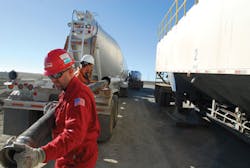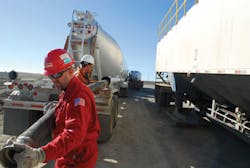Upcoming changes in shale fracturing could impact proppant use
Don Warlick,WarlickEnergy
Three issues involved in current shale development dynamics may have measurable impact on the use of proppants. For the past several years there has been a critical supply/demand imbalance across all proppant types with suppliers scrambling to add capacity for raw sand, resin-coated sand and ceramics. But adjustments are coming that could affect proppant demand in the future:
- Changes in the number of wells drilled in liquids-rich (oil, NGLs) shale plays
- Potential for increased drilling in existing US gas shales
- Ongoing evaluation leading to improvements in completion and fracturing program designs.
Liquids-rich drilling
Development in US liquids-rich shales is dependent on drilling in leading areas like the Bakken, Eagle Ford, Permian and others. Essentially all these plays will be positive with WTI prices above $70/Bbl such that overall economics can produce at least a 10% IRR. So far in 2012 the WTI spot price for crude was highest on March 1st at $108.76, at its lowest on June 21st at $77.91 and at this writing, closed above $86 on November 2nd. WTI crude prices are anticipated to remain largely in the $80-$100 window, so wet-play shale drilling in the US should remain on a positive trend through 2013.
Drilling in gas shales
This environment is improving. It's been a slog in the natural gas space since January 2010 when the wellhead price peaked at $5.69/MCF. After a steady slide it bottomed at $1.89/MCF in April of this year, but has since improved on a rather steady basis, hitting $3.86 on November 2nd. The principal drivers have been growing gas consumption in the power generation sector and much-reduced drilling across US gas shales. Further, Raymond James is forecasting gas to bump up from $2.82 this year to $3.75 in 2013 and $4.25 in 2014 – positive support for natural gas drilling and development in the near future.
Improved program designs
A principal goal in development of unconventional reservoirs is to provide as much reservoir contact with the rock face as possible, optimized by proper lateral length, ideal number of stages, fracture conductivity techniques and other factors.
Indeed, there is increased service intensity principally determined by lateral length and frac stages which has risen significantly since 2008. For example, Simmons & Company reported in the Eagle Ford shale that typical lateral lengths and frac stages in 2008 were 3,700 ft and 11 stages, respectively. In 2011 those numbers increased to 6,000 feet and 18 stages. Simmons further estimated that "leading edge" estimates this year are around 9,200 feet and 32 stages – incredible changes in fracturing dynamics.
CARBO engineers unload ceramic proppant in Rock Springs, Wyo.Photo courtesy of CARBO Ceramics Inc.
Hydraulic fracturing and the costs associated with it are the most expensive component in drilling and completion today. As a result, there is much more attention being given to optimizing completion and fracturing programs plus assessments of overall efficiencies related to cost. With less drilling in gas reservoirs and more focus on microdarcy rock in liquids-rich plays, there may be a case for increased numbers of frac stages and the possibility that less fluid and proppant volumes may be required.
Concurrently, there is significant attention being given to frac water demand and handling growing frac flowback volumes, reasons themselves to study and evaluate optimization of water and proppant materials. The literature and research going forward indicates that the number of stages that may be required to drain microdarcy-permeability rock could be increased; some note 40-50 stages may even be appropriate in a more technical approach to the overall issue of efficient production and improved ROI in completion and fracturing design.
Summary
Research and evaluation continues in an effort to make sense of what is best in fracturing programs in relation to lateral lengths, ideal number of stages and material volumes. Continued assessment is underway, but there are indications that effective placement along with more stages with reduced fluid and proppant volumes could be the industry's path forward in fracturing US shales. OGFJ
About the author
Don Warlick is president of WarlickEnergy, a Houston-based energy intelligence firm. The company publishes a series of special reports on each of the leading US unconventional shales and provides market research services addressing North American and International oil & gas markets.


